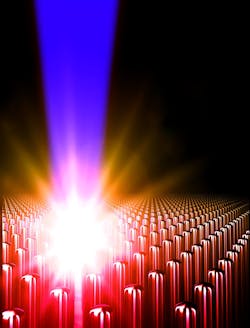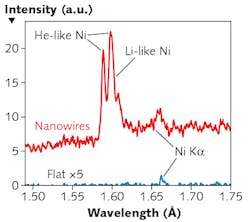High-energy Lasers: Compact ultra-intense lasers and nanostructures open a path to extreme pressures
JORGE J. ROCCA, in collaboration with VYACHESLAV SHLYAPTSEV, REED HOLLINGER, CLAYTON BARGSTEN, ALEXANDER PUKHOV, VURAL KAYMAK, RICCARDO TOMMASINI, RICHARD LONDON, JAEBUM PARK, and MARIA GABRIELA CAPELUTO
Heating matter into the ultrahigh-energy density (UHED) regime characterized by pressures greater than a gigabar—found, for example, in the center of stars and in the spherical compression of inertial confinement fusion (ICF) capsules driven by lasers like that at the National Ignition Facility (NIF)—is a very challenging task. The UHED plasma regime is of interest for fusion studies; for the generation of intense flashes of x-rays, gamma rays, and high-energy particles, including neutrons; and for the study of atomic processes in the conditions encountered in extreme laboratory and astrophysical environments.
Unfortunately, the creation of UHED plasmas in the laboratory has been mostly limited to the central hot-spot of these imploded capsules in ICF experiments,1, 2 and even some of today's most powerful lasers can fall short of achieving the UHED regime when irradiating solid flat targets. In this traditional plasma heating scheme, the leading edge of the intense laser pulse rapidly creates a plasma blow-off that prevents the remainder of the laser pulse from directly heating the solid density target. Heating by hot electrons using today's most energetic short-pulse lasers just surpassed the boundary into the UHED regime.3
We are pursuing a different approach to reach the UHED regime with compact, ultrashort-pulse (USP) lasers: the irradiation of high-aspect-ratio, vertically aligned nanowire arrays with ultrahigh-contrast femtosecond laser pulses of only joule-level energy focused to relativistic intensity (see Fig. 1).4,5
This strategy provides a unique combination of nearly complete laser absorption and drastically enhanced light penetration into near-solid average density targets, where light is trapped and almost totally absorbed. This allows the material to be volumetrically heated well into UHED territory, clearing a pathway to the UHED plasma regime using joule-class femtosecond tabletop lasers that can be repetitively fired.
Nanostructure irradiation with relativistic intensities
Structured targets, including gratings, "smoked targets" (metal evaporated and deposited in a gas atmosphere), nanospheres, and nanowires, have been successfully used to increase absorption of laser radiation, as evidenced by the observation of enhanced x-ray emission (see references 18-24 in B. Bargsten et al., Sci. Adv., 3, 1, e1601558 [2017]). Nevertheless, arrays of high-aspect-ratio aligned nanowires separated by vacant gaps are unique in allowing volumetric heating by deep penetration of femtosecond optical laser pulses of relativistic intensity into near-solid-density material.
In the irradiation process, electrons are ripped from the surface of the nanowires by the intense laser field that accelerates them into the gaps between the wires to acquire high energy. Electron collisions with the nanowires heat the material to extreme temperatures, causing the nanowires to explode, rapidly filling the gaps with plasma. When the gaps are filled, a continuous, critical electron density layer is formed that forbids further coupling of laser energy into the material.
The use of femtosecond laser pulses of relativistic intensity allows for very efficient coupling of energy deep into the nanowire array, heating a large volume of near solid-density material several microns in depth to multi-kiloelectronvolt temperatures. With this volumetric plasma heating approach, the UHED regime with gigabar pressures can be accessed with a relatively modest intensity of 5 × 1018 W/cm3.
In experiments at Colorado State University, we have irradiated arrays of vertically aligned nickel (Ni) and gold (Au) nanowires with ultrahigh-contrast pulses of approximately 50 fs duration from a frequency-doubled (λ = 400 nm), high-power Ti:sapphire laser. The ultrahigh contrast is critical, as a relatively low-intensity pre-pulse can destroy the array by forming a critical density surface prior to the arrival of the high-intensity ultrashort pulse.
X-ray spectra obtained by focusing a 5 × 1018 W/cm2 laser pulse onto 55- to 80-nm-diameter nanowires with an average density of approximately 12% solid density show the generation of highly ionized plasmas. Spectra from vertically aligned, 55 nm Ni nanowires show a very highly ionized plasma with strong emission from the 2p-1s (λ = 1.588 Å) and intercombination lines of helium (He)-like Ni (Ni+26), along with lithium (Li)-like lines (see Fig. 2).This spectrum differs dramatically from that corresponding to a polished flat target irradiated at the same conditions that only shows line emission from the Ni Kα line at 1.658 Å. The Kα emission is produced mainly by high-energy electrons, while generation of the He-like ion transitions requires a hot thermal plasma to generate and excite the highly stripped ions.
It is remarkable that the He-like line emission from the nanowire target exceeds the intensity of the Kα line at this irradiation intensity, since in previous work with copper (Cu) foils, the emission from the Kα lines was only surpassed at irradiation intensities >2 × 1020 W/cm2.6 The aligned Ni nanowire target produced an increase of more than 50X in x-ray flux in this 7–8 keV spectral region. Similar enhancements were also observed in the 1 keV photon energy region in agreement with previous experiments.7
Similarly, a near-solid-density Au plasma with an extraordinarily high degree of ionization was created by irradiating an array of 80-nm-diameter Au wires. The Au nanowire spectra displays strong Au M-shell emission with unresolved 4–3 lines from ions ranging from cobalt (Co)-like Au (Au+52) to gallium (Ga)-like Au (Au+48). Both the spectra and the filtered photodiode array signals from the Au targets show a dramatic increase in x-ray yield, with respect to flat solid targets irradiated by the same pulse.
Generation of extreme energy densities
The energy density and pressure for hot electron gases are given by integrals of the energy and momentum-velocity product, weighted by the distribution function. We have calculated the energy density directly from the particle data using particle-in-cell (PIC) simulations, and estimated the pressure using a formula for an equilibrium relativistic gas (see Fig. 3). The electrons stripped from the wires by the strong electric field of the laser are accelerated towards the substrate.Charge balance demands the generation of a large laser-induced return current through the nanowires. The strong quasi-static, self-generated azimuthal magnetic field that results pinches the nanowires into a hot, extremely dense plasma.8 For the case of 55-nm-diameter Ni nanowires irradiated at an intensity of 4 × 1019 W/cm3, computations show a plasma density surpassing 1024 cm-3 with an energy density of approximately 20 GJ cm-3, and pressures >100 Gbar are quickly reached within the wires near their tips.
The laser pulse continues to propagate down the length of the wires and deep into the array, as long as the interwire gaps remain free of dense plasma. As the wires expand, the interwire gaps are filled with a super-critical density plasma. Collisions homogenize the plasma, creating a uniform plasma layer several microns thick in which the atoms are ionized up to the He-like stage, as observed in the measurements.
Expansion of the wires continues to progressively close the interwire gaps along the length of the wires until the whole target cross-section is filled with material at an energy density of 1 GJ/cm3 and pressure of 7 Gbar.
We have conducted measurements of the heat penetration in the nanowire array measuring the depth at which a tracer nanowire segment of different atomic composition (such as Co) is ionized to the He-like stage. For the irradiation conditions mentioned above, we measured a penetration depth of 4–5 μm in agreement with simulations, confirming volumetric heating.
In addition, we have also conducted PIC simulations to predict the plasma conditions that could be achieved by further increasing the laser irradiation intensity to 1 × 1022 W/cm2. The results suggest the generation of unprecedented energy densities and pressures for an array of 400-nm-diameter Au nanowires irradiated with a 30 fs pulse (see Fig. 4). The plasma density in the nanowires during the nanoscale pinch (nanopinch) compression phase reaches 2 × 1025 cm-3, which exceeds 3000 times the critical density.Other laser-target configurations could reach even-higher densities during the nanopinch process-as high as 6 × 1025 cm-3. Such extreme peak densities would approach those obtained in fusion hot spots using megajoule laser energies at NIF (around 1 × 1026 cm-3),9 while potentially reaching higher temperatures.
The energy density within the nanowires is predicted to reach a peak value of 2 TJ cm-3 or equivalent to a pressure of the order of terabars near the end of the laser pulse. The expansion of the heated nanowires is computed to create a plasma layer in which the energy density is 80 GJ cm-3, equivalent to a 350 Gbar pressure—larger than the pressure in the sun's interior.
Such nanowire array plasma conditions are only comparable to those obtained when the NIF capsule is highly compressed, effectively creating a new laboratory plasma regime. These extreme energy densities offer significant advantages for the efficient generation of ultrashort pulses of x-rays and neutrons.
In the case of x-rays, the large plasma density decreases the radiative lifetime. This results in an increase in radiative cooling to hydrodynamic cooling-rate ratios, leading to a large increase in x-ray conversion efficiency. In the case of neutron generation by deuterium-deuterium or deuterium-tritium fusion reactions, the high density of energetic ions is a significant advantage because the reaction rate is proportional to the square of the density.
These aligned nanostructure plasmas share some similarities to the efficient volumetric heating of clusters in a supersonic gas jet,10 but with the additional advantage of having several-orders-of-magnitude higher average density, potentially leading to ultrashort neutron pulses with record fusion-neutron yields with compact lasers.
In summary, the irradiation of aligned nanowire arrays with high-contrast ultrashort pulses opens a path to obtaining unprecedented pressures in the laboratory with compact lasers for the study of high-energy-density physics, high ionization states of heavy atoms in high-density plasmas, and radiation transport effects at ultrahigh pressures, temperatures, and densities. These plasmas can lead to record conversion efficiency of optical laser light into ultrafast x-ray flashes, and to the efficient production of ultrafast neutron pulses by fusion in near-solid density plasmas.
ACKNOWLEDGEMENTS
This work was supported by the Fusion Energy Program, Office of Science, of the U.S. Department of Energy; the Air Force Office of Scientific Research; and by previous support from the Defense Threat Reduction Agency and NESTec. The work of LLNL researchers Riccardo Tommasini, Richard London, and Jaebum Park was performed under the auspices of the U.S. Department of Energy.
REFERENCES
1. R. Nora et al., Phys. Rev. Lett., 114, 045001 (2015).
2. T. Dittrich et al., Phys. Rev. Lett., 112, 055002 (2014).
3. D. Hoarty et al., Phys. Rev. Lett., 110, 265003 (2013).
4. M. Purvis et al., Nat. Photon., 7, 10, 796–800 (2013).
5. B. Bargsten et al., Sci. Adv., 3, 1, e1601558 (2017).
6. W. Theobald et al., Phys. Plasmas, 13, 043102 (2006).
7. G. Kulcsár et al., Phys. Rev. Lett., 84, 5149 (2000).
8. V. Kaymak et al., Phys. Rev. Lett., 117, 035004 (2016)
9. D. Clark et al., Phys. Plasmas, 23, 072707 (2016).
10. T. Ditmire et al., Nature, 398, 489 (1999).
Jorge Rocca is a University Distinguished Professor, Vyacheslav Shlypatsev is a research scientist, and Reed Hollinger and Clayton Bargsten are graduate students, all at Colorado State University (CSU), Fort Collins, CO; e-mail: [email protected]; www.colostate.edu; Alexander Pukhov is a professor and Vural Kaymak is a researcher, both at Heinrich Heine Universität Düsseldorf, Düsseldorf, Germany, www.uni-duesseldorf.de; Riccardo Tommasini, Richard London, and Jaebum Park are scientists at Lawrence Livermore National Laboratory, Livermore, CA; www.llnl.gov; and Maria Gabriela Capeluto is a lecturer and researcher at the University of Buenos Aires, Buenos Aires, Argentina; www.uba.ar.



